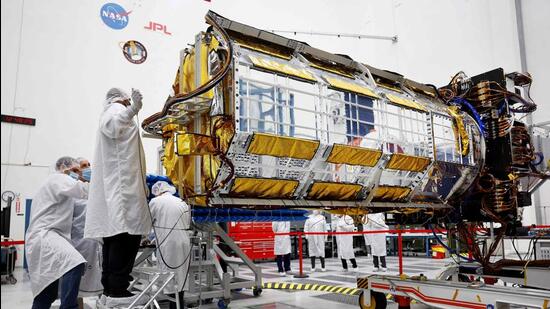NASA hands over payload of NISAR satellite to Isro
NASA’s Jet Propulsion Laboratory’s (JPL) director Laurie Leshin said that the handover of the payload marks an “important milestone in our shared journey to better understand planet earth and our changing climate”.
The National Aeronautics Space Administration (NASA) on Saturday handed over the payload for the NISAR satellite to Indian Space Research Organisation (Isro), people aware of the matter said on Saturday.

NISAR (NASA-Isro Synthetic Aperture Radar), is an earth science satellite jointly built by the NASA and the Isro.
The payload was send-off during a ceremony in California. The satellites’s launch is expected by the first quarter of 2024, said Isro in a statement.
NASA’s Jet Propulsion Laboratory’s (JPL) director Laurie Leshin said that the handover of the payload marks an “important milestone in our shared journey to better understand planet earth and our changing climate”.
“NISAR will provide critical information on earth’s crust, ice sheets, and ecosystems. By delivering measurements at unprecedented precision, NISAR’s promise is new understanding and positive impact in communities. Our collaboration with Isro exemplifies what’s possible when we tackle complex challenges together,” Leshin said according to a statement issued by JPL on Saturday.
“Today we come one step closer to fulfilling the immense scientific potential NASA and Isro envisioned for NISAR when we joined forces more than eight years ago,” Isro chairman S Somanath said during the handover.
He added, “This mission will be a powerful demonstration of the capability of radar as a science tool and help us study earth’s dynamic land and ice surfaces in greater detail than ever before.”
Since early 2021, engineers and technicians at JPL have been integrating and testing NISAR’s two radar systems – the L-band SAR provided by JPL and the S-band SAR built by Isro, the space bodies said in a joint statement. They said, later this month, the SUV-size payload will be moved into a special cargo container for a 14,000km flight to India’s UR Rao Satellite Centre in Bengaluru. There it will be merged with the spacecraft bus in preparation for a 2024 launch from Satish Dhawan Space Centre in Andhra Pradesh.
Over the course of its three-year prime mission, the satellite will observe nearly the entire planet every 12 days, making observations day and night, in all weather conditions.
Stay updated with all top Cities including, Bengaluru, Delhi, Mumbai and more across India. Stay informed on the latest happenings in World News along with Delhi Election 2025 and Delhi Election Result 2025 Live, New Delhi Election Result Live, Kalkaji Election Result Live at Hindustan Times.
Stay updated with all top Cities including, Bengaluru, Delhi, Mumbai and more across India. Stay informed on the latest happenings in World News along with Delhi Election 2025 and Delhi Election Result 2025 Live, New Delhi Election Result Live, Kalkaji Election Result Live at Hindustan Times.





